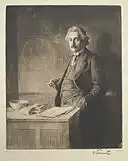
As the library’s first Humanities Fellow, my job is to make the humanities, from literature to public policy to history, more interesting, accessible, and engaging for the public through programs, collections, and other library activities. Ever on the hunt for new ideas, the inspiration for the library’s current History of Science series grew out of a conversation with my uncle.
My uncle, who built his own telescope and airplane and who loves puns and humor, was also my sixth grade science teacher. This was sometimes a trying experience for me as an awkward middle schooler, but having thankfully left that experience behind years ago, he and I recently discussed his reading selections on the history of science. What fascinated him about this topic was the combination of science and history to create narratives illuminating the lives of scientists holistically, viewing them not only through the lens of their work but also their cultural context. That inspiration led to building the library’s History of Science series, presented with support from the National Endowment for the Humanities, which runs through April 24.
With thanks to the Institute for Advanced Study and the program for the History of Science at Princeton University, we’re pleased to showcase the combination of the humanities and the sciences, drawing upon Princeton’s rich scholarly community to bring these lectures, author talks, and book discussions to the public. If you were fortunate enough to be in the audience for both the “Particle Fever” screening and the brilliant and entertaining discussion between Freeman Dyson and Nima Arkani-Hamed, you already have experienced some of the highlights of this special series. Take a look through the program guide for more events and reading suggestions.
As Princeton University’s Jennifer M. Rampling, Assistant Professor of History in the Program in History of Science, says, in her introduction to the series (read the full text in the guide), “…the job of history of science is not to plot timelines of major discoveries, or to write up the lives of famous individuals like Isaac Newton and Marie Curie – although it may well involve those activities. Histories of science are as much about the “bumps” as they are about tales of scientific success…” We hope you will join us as we explore both the bumps and the successes.
Photo: Albert Einstein, Etching by Ferdinand Schmutzer, 1921. Photo courtesy of Wikimedia Commons
